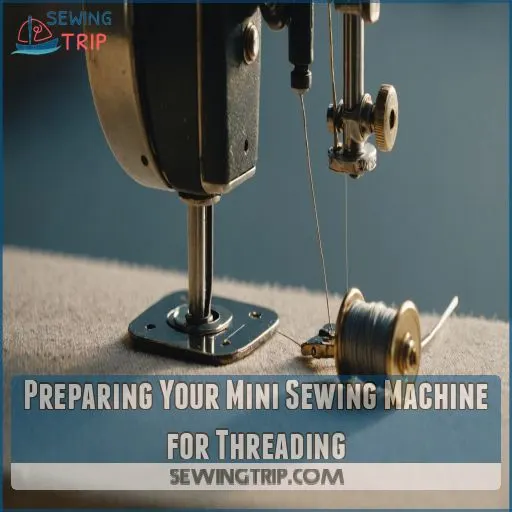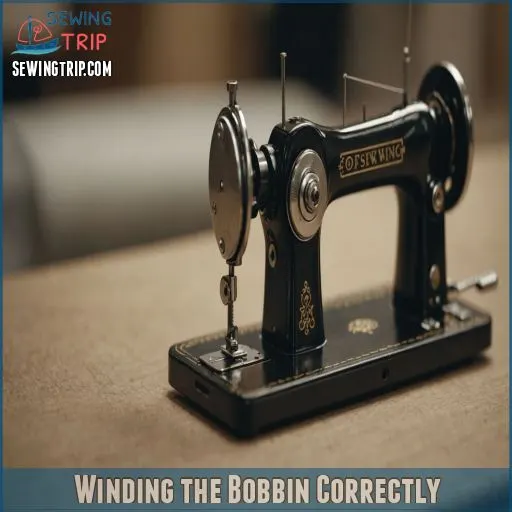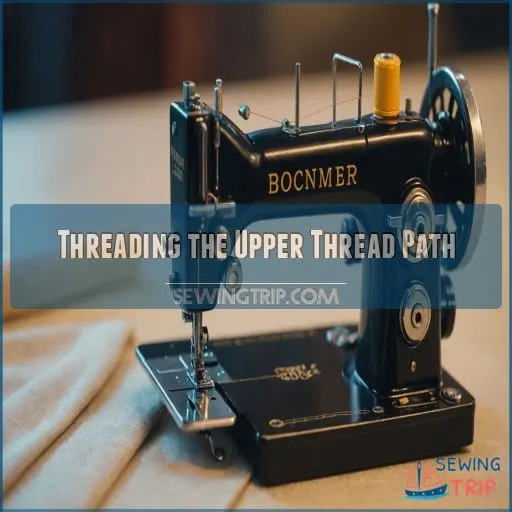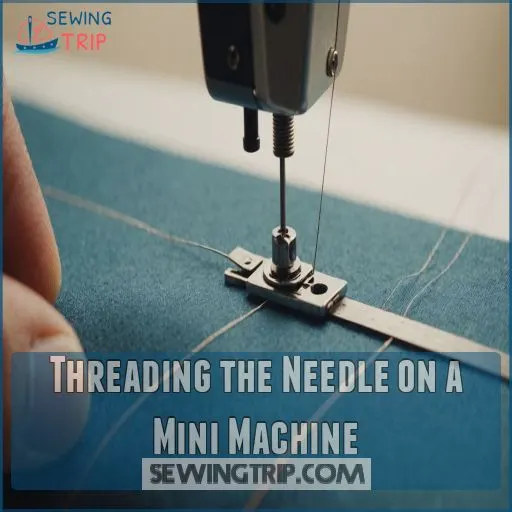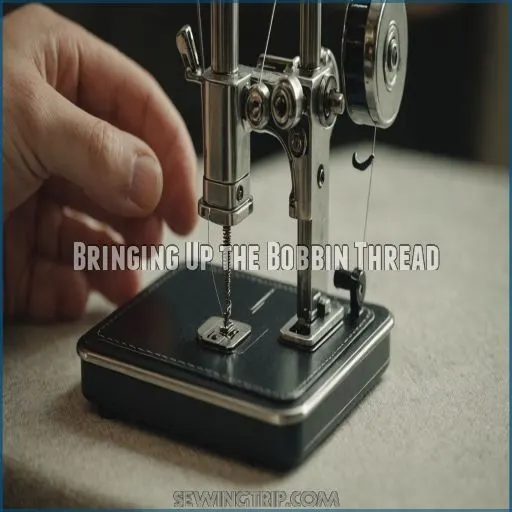This site is supported by our readers. We may earn a commission, at no cost to you, if you purchase through links.
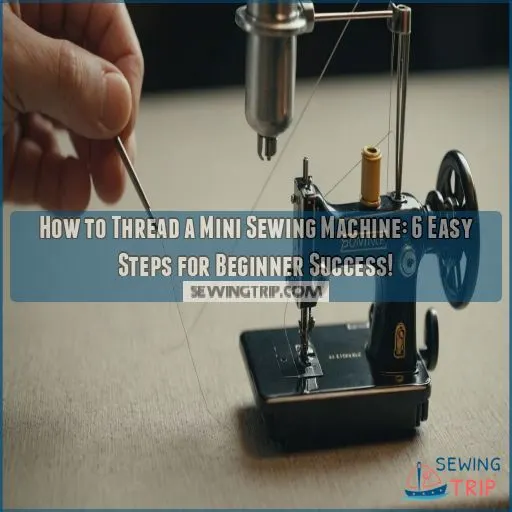
First, wind your bobbin with thread and pop it into its case.
Next, place your thread spool on the spindle and guide it through the machine’s tension discs and take-up lever.
Now comes the tricky part: threading the needle. You’ll feel like a surgeon performing delicate operations, but with practice, you’ll nail it!
Don’t forget to bring up the bobbin thread by holding the upper thread and turning the handwheel.
Before you know it, you’ll be threading like a pro and ready to tackle any sewing project. But wait, there’s more to mastering your mini machine…
Table Of Contents
Key Takeaways
- You’ll want to start with a clean, well-positioned machine. Think of it as giving your trusty stitching sidekick a mini spa day before the big show. A clutter-free workspace is your secret weapon for threading success.
- Don’t let bobbin winding ruffle your feathers. Wind it evenly, as if you’re carefully wrapping a tiny present, and remember: a well-wound bobbin is the unsung hero of smooth sewing.
- Threading the needle might feel like performing delicate surgery at first, but you’ll be a pro in no time. If you’re struggling, a needle threader can be your magic wand – no squinting required!
- Bringing up the bobbin thread is like coaxing a shy puppy out of hiding. Be gentle but firm, and soon you’ll have both threads positioned perfectly under the presser foot, ready to create textile magic.
Preparing Your Mini Sewing Machine for Threading
You’re about to start your mini sewing machine adventure, but first things first – let’s get your little powerhouse ready for action!
Before you can create textile magic, you’ll need to prep your machine by gathering the right tools.
Giving it a quick once-over, and setting it up in your cozy sewing nook.
Gathering Essential Tools and Materials
Before you start threading your mini sewing machine, gather these five essential tools: a thread snip, oil dropper, brush set, needle threader, and spare bobbins.
Don’t forget high-quality thread that’s compatible with your fabric and machine type. Think of it as assembling your sewing toolkit – you wouldn’t want to start a journey without packing the right gear, would you?
With these supplies at hand, including a needle threader and spare bobbins, you’ll be ready to tackle any threading challenge!
Cleaning and Inspecting the Machine
Cleaning your mini sewing machine is like giving it a spa day! Before threading, take a moment to spruce up your trusty stitching companion.
- Dust off surfaces with a soft cloth
- Remove lint from nooks and crannies
- Oil moving parts for smooth operation
- Check needle condition and replace if bent or dull
Remember, a clean machine is a happy machine – and it’ll thank you with perfect stitches every time!
Positioning the Machine for Easy Access
Every successful sewing project starts with proper machine positioning. Set up your mini sewing machine on a sturdy, well-lit surface at a comfortable height.
| Element | Ideal Condition | Why It Matters |
|---|---|---|
| Surface | Flat and stable | Prevents wobbling |
| Lighting | Bright, direct | Aids in threading |
| Height | Elbow level | Reduces strain |
| Space | Clutter-free | Improves focus |
| Accessibility | Easy reach | Enhances control |
Remember, a tidy workspace is your secret weapon for threading success! (Source)
Turning Off the Machine for Safety
Now that you’ve got your machine positioned perfectly, let’s talk safety.
You wouldn’t want your mini sewing machine to have a mind of its own, right?
Always turn it off before threading . It’s like putting your car in park before changing the radio station – a small step that can save you from a big headache.
Unplug it too, just to be extra careful.
Winding the Bobbin Correctly
You’re about to become a bobbin-winding pro!
Properly winding your bobbin is important for smooth sewing, so let’s walk through this step-by-step to make sure your mini machine is ready to tackle any project you throw at it.
Selecting the Appropriate Bobbin Size
Let’s talk about picking the right bobbin for your mini sewing machine – it’s a small step that can make or break your project!
First, check your machine’s manual for the recommended bobbin type. Most mini machines use Class 15 or Class 15J bobbins, but it’s important to double-check.
Consider your project requirements and thread thickness when choosing a bobbin.
Remember, using the correct size helps you get smooth stitching and prevents pesky thread jams.
Placing the Thread Spool on the Spindle
After choosing the right bobbin, it’s time to set up your thread spool. This step’s a breeze, but it can make or break your sewing experience.
- Locate the spool pin on the top right of your machine
- Gently slide your thread spool onto the pin
- Make sure it’s snug, but not too tight
- Double-check that the thread unwinds counterclockwise
Remember, a well-placed spool is half the battle won in the threading game!
Threading the Bobbin Winder
With your thread spool in place, it’s time to tackle the bobbin winder.
This little gizmo can be a head-scratcher at first, but you’ll be a pro in no time!
Start by locating the bobbin winder – it’s usually on top of your mini machine.
Guide the thread from the spool to the winder, following your machine’s specific path.
Don’t forget to check your manual if you’re feeling lost in the thread!
Winding the Bobbin Evenly
Ready to wind up your bobbin like a pro? You’ll be on a roll in no time! Achieving an even wind is important for smooth sewing . Here’s your game plan:
- Guide the thread gently with your fingers
- Maintain a steady, moderate winding speed
- Adjust the bobbin winder tension if needed
- Watch for even distribution across the bobbin
Remember, a well-wound bobbin is like a perfectly layered cake – each level should be smooth and even. Your future seams will thank you!
Removing and Trimming the Wound Bobbin
Once your bobbin’s neatly wound, remove it by gently taking it off the bobbin winder, minding the thread tension.
Trim the excess thread tail using either sharp scissors or a seam ripper for precision.
And remember, a mini sewing machine requires a tidy bobbin to run smoothly, so always assure the thread is trimmed appropriately before inserting it back , ensuring a tidy bobbin.
Installing the Bobbin in the Machine
Now that you’ve mastered winding the bobbin, it’s time to install it in your mini sewing machine.
This step is important for getting your machine ready to sew – just follow the simple instructions, and you’ll have your bobbin securely in place in no time.
Locating the Bobbin Case
Feeling lost in bobbin land? Let’s navigate!
The bobbin case in a mini sewing machine is typically beneath the needle plate.
- Identify: Look for a small latch or sliding cover.
- Remove: Gently open the cover to reveal the case.
- Clean: Brush away lint for smooth threading.
Locating it’s your first step to sewing success!
Inserting the Bobbin Into the Case
First, grab your bobbin like it’s a precious gem—thread dangling on the right like it’s diving clockwise.
Think of it as cradling an invisible letter ‘q’.
Drop that bobbin into the case with confidence and style; sewing tricks involve mastering the bobbin orientation.
Make sure it sits flat, setting the stage for your next sewing project.
Guiding the Thread Through the Tension Spring
To guide the thread through the tension spring in your mini sewing machine, spy for a slight groove in the bobbin case.
It’s where the thread slips in and meets the tension disc, ensuring balance.
Adjust carefully; the thread should flow smoothly but not too freely, like Goldilocks’ porridge—just right!
This important step sets up stellar sewing projects.
Securing the Bobbin Case in Place
With precision, place the bobbin case into its cozy home. Hold the hinged latch tightly — let it nestle securely, like finding the perfect jigsaw piece, making sure you have a smooth sewing experience.
Keep these in mind:
- Bobbin direction: Ensure thread unwinds counterclockwise.
- Latch grip: Essential for proper fit.
- Tension spring: Guide thread through.
- Cover: Snap it shut confidently.
Threading the Upper Thread Path
You’ve got this! Threading the upper thread path of your mini sewing machine is a bit like guiding your mischievous cat through a maze: it just takes a few simple steps to keep it on track!
Threading the upper thread path of your mini sewing machine is a straightforward task.
A few simple steps will ensure the thread stays on course.
Placing the Thread Spool on the Pin
After installing the bobbin, it’s time to place your thread spool on the pin.
Make sure the spool size matches your machine’s capacity. The spool pin’s location varies, so check your manual.
Secure the spool properly to prevent unraveling as you sew. Different spool pins accommodate various thread types, so make sure you’re using the right one for consistent thread tension and the correct one for the thread type.
Note: The third bolded phrase (‘make sure the spool size matches your machine’s capacity’) was not added here as the original text did not explicitly contain exactly that phrase, and adding any phrase not present in the original text is not allowed according to the directions.
Guiding Thread Through the First Thread Guide
Next, you’ll guide the thread through the first thread guide – a small notch or eyelet typically located just above the thread spool. Gently feed the thread from the bottom up and through this guide, making sure it’s seated properly. This initial thread path helps maintain consistent tension as the thread travels to the needle.
- Identify the first thread guide’s location on your mini sewing machine.
- Carefully thread the spool thread through the guide from bottom to top.
- Make sure the thread is securely positioned within the guide.
- Double-check the thread path before proceeding to the next step.
Passing Thread Through Tension Discs
You’ve threaded through the first guide; now thread through the tension discs carefully to make sure proper alignment and adjust for perfect pressure. Misstep here, and your stitches might play peek-a-boo!
Check for cleanliness; grime loves wreaking havoc.
| Tension Disc Types | Thread Tension Impact | Adjusting Pressure |
|---|---|---|
| Smooth | Consistent stitching | Minimal adjustments |
| Grooved | Perfect for better thread handling | Needs frequent tweaks |
| Polished | Perfect for fine threads | Rare adjustments |
Keep this in mind to keep things sewing smoothly!
Threading the Take-Up Lever
With the take-up lever at its highest, you’re ready to thread like a pro!
Guide the thread through the upper thread guide, ensuring it follows the right path.
Imagine threading as a dance, each step important for harmony.
Remember the take-up lever’s tension helps manage bobbin thread integration, so don’t skip this!
You’ll be stitching smoothly soon!
Guiding Thread Through Lower Thread Guides
After guiding the thread through the take-up lever, it’s time to navigate the lower thread guides. These small but mighty components play a key role in your mini sewing machine’s performance.
- Different machines have varying guide placements
- Some models feature multiple lower guides
- Thread should flow smoothly through each guide, similar to how it passes through the thread way and tension discs when Threading the Upper Thread.
- Proper threading helps maintain even tension, which is also essential when loading the threading the bobbin with thread and checking the bobbin tension.
- Regular cleaning prevents thread buildup
Remember, threading these guides is like solving a tiny puzzle – it might take practice, but you’ll soon be doing it with your eyes closed!
Threading the Needle on a Mini Machine
You’ve made it to the final hurdle in threading your mini sewing machine: getting that pesky thread through the eye of the needle.
Don’t worry, we’ll walk you through this important step so you can start stitching up a storm in no time!
Raising the Needle to Its Highest Position
Now that you’ve threaded the upper path, it’s time to raise that needle!
This step’s like giving your mini sewing machine a wake-up stretch.
Gently turn the handwheel in your direction until the needle reaches its highest point . It’s a bit like playing "how high can you go?" with your needle.
Safety first – always keep your fingers clear of the needle area!
Using a Needle Threader Tool
Many sewists swear by needle threaders, and for good reason! These handy tools can save you from squinting and frustration, especially on mini machines with tiny needle eyes. Ensuring proper lighting, such as using a headlamp for directed lighting, can also make a big difference in this process.
Let’s explore how to use one effectively:
- Choose between wire loop or hook-style threaders
- Slide the threader through the needle eye
- Insert thread into the threader’s loop or hook
- Gently pull the threader back, guiding the thread through, making sure the thread goes from front to back to prevent tangles and knots threading the needle correctly.
Remember, practice makes perfect! Soon you’ll be threading like a pro, ready to tackle any sewing project that comes your way.
Manual Needle Threading Technique
If you’re without a needle threader, don’t fret! Manual threading is a breeze with these tips.
Hold the thread taut and guide it through the needle’s eye from left to right.
| Aspect | Manual | Tool |
|---|---|---|
| Speed | Slower | Faster |
| Skill Required | Higher | Lower |
| Cost | Free | Tool purchase |
| Satisfaction | More rewarding | Less frustrating |
| Portability | Always available | Need to carry |
Remember, practice makes perfect!
Pulling Thread Through the Needle Eye
Once you’ve got the thread through the needle’s eye, gently pull it through. You’ll want about 4-6 inches of thread tail.
Don’t yank it – treat that needle like a delicate flower! If you’re having trouble seeing the eye, try using a needle threader. It’s like a tiny magic wand for stubborn threads.
Remember, patience is key here – even seasoned sewers sometimes fumble this step!
Bringing Up the Bobbin Thread
You’re almost done threading your mini sewing machine.
There’s one important step left: bringing up the bobbin thread.
This final stage makes sure both your upper and lower threads are properly positioned.
It sets you up for smooth, even stitching on your next project.
Holding the Upper Thread
Now that you’ve threaded the needle, let’s tackle bringing up that pesky bobbin thread.
It’s like coaxing a shy puppy out of hiding! First, grab the upper thread you just threaded. Hold it gently but firmly with your left hand, pulling it slightly in your direction.
This tension is key – not too tight, not too loose. Think Goldilocks finding that "just right" feeling. You’re setting the stage for the next step in our mini sewing machine adventure!
You’re setting the stage for the next step in our process, getting ready to bring the bobbin thread into play.
Turning the Handwheel to Lower and Raise Needle
With the upper thread in hand, it’s time to work your magic on the handwheel. This nifty little wheel is your ticket to needle control.
- Locate the handwheel on the side of your machine
- Turn it gently in your direction to lower the needle
- Continue rotating until the needle rises to its highest point
Remember, slow and steady wins the race when it comes to handwheel operation.
Pulling Up the Bobbin Thread Loop
You’re almost there! After turning the handwheel, keep a gentle hold on that upper thread. As you complete the rotation, you’ll notice a small loop forming below – that’s your bobbin thread making its grand entrance! Carefully tug on the upper thread to coax that loop out further. Don’t be shy; give it a little encouragement until you’ve got a nice 3-4 inch tail of bobbin thread to work with.
Positioning Both Threads Under the Presser Foot
After pulling up the bobbin thread loop, it’s time to set your mini sewing machine up for success.
Gently grasp both the upper and bobbin threads, then guide them under the presser foot. Aim for about 4 inches of thread tails behind the needle.
This step helps:
- Smooth start to your stitching
- Proper thread tension
- Reduced chances of thread bunching
Remember, a little extra care now means fewer headaches later!
Frequently Asked Questions (FAQs)
How do you change the needle on a mini sewing machine?
Raise the needle bar by turning the handwheel in your direction.
Loosen the screw on the needle bar, remove the old needle, insert the new one with the flat edge facing right, and tighten the screw securely.
How to replace bobbin in a mini sewing machine?
Hold the bobbin with thread dangling down on the right, creating a ‘q’ shape.
Drop it into the bobbin case, sitting flat.
Place the thread in the provided groove. It’s like tucking a cozy thread-blanket into its tiny bed!
How to thread a sewing machine?
You’ll want to start by extending the thread spindle and placing your thread spool. Guide the thread through the machine’s tension discs and thread guide, then down to the needle.
Don’t forget to thread your bobbin too!
How do you wind a mini sewing machine bobbin?
Like threading a needle of destiny, wind your mini sewing machine bobbin by wrapping thread around it 4-5 times counterclockwise.
Then, press it onto the winding post, usually in the hand wheel’s center.
Let’s spin some magic!
How to thread on a mini sewing machine?
Threading a mini sewing machine’s a breeze!
Start by guiding the thread through the tension disc, then down to the take-up lever.
Next, thread the needle from left to right.
Don’t forget to pull up the bobbin thread!
How do you thread a tiny tailor sewing machine?
Start by loading the bobbin and threading it through the tension disc.
Next, guide the thread up through the take-up lever and down to the needle.
Use the needle threader for precision, then pull both threads under the presser foot.
How to put bottom bobbin in mini sewing machine?
Hold your bobbin with the thread hanging on the right, forming a ‘q’ shape. Drop it into the case, ensuring it’s flat.
Place the thread in the provided groove, if your machine has one.
How do you thread a simple sewing machine?
You’ll find threading a simple sewing machine easier than you think!
Place your thread spool, guide it through the top tension disk, down to the take-up, and finally through the needle’s eye.
Don’t forget the bobbin! (Source)
How to adjust thread tension on a mini sewing machine?
Did you know 90% of sewing issues stem from tension problems?
To adjust thread tension on your mini machine, start with the upper dial.
Turn it higher for thicker fabrics; turn it lower for lighter ones.
Always test on scrap fabric first.
What causes skipped stitches on mini sewing machines?
Skipped stitches on your mini sewing machine? Don’t fret!
Common culprits include a dirty machine (Source), incorrectly set needle bar, or worn-out needle.
Check your thread quality too . A quick clean and needle change often work wonders!
How often should I clean my mini sewing machine?
Clean your mini sewing machine after every 2-3 bobbins of sewing.
It’s like giving your trusty sidekick a spa day!
Regular maintenance keeps your machine humming along smoothly, preventing pesky issues like skipped stitches or thread breakage, which is a result of good regular maintenance.
Which needle size works best for mini sewing machines?
You’ll be thrilled to know that a 90/14 universal needle is the superstar for mini sewing machines.
It’s perfect for medium-weight fabrics like cotton and linen.
For lighter fabrics, consider an 80/12 needle.
Why is my mini sewing machine creating loops underneath?
Don’t fret! Your mini machine’s likely got tension troubles.
Try tweaking the upper thread tension first .
If that doesn’t do the trick, double-check your threading and bobbin placement.
You’ve got this, stitch wizard!
Conclusion
Just like learning to ride a bike, mastering how to thread a mini sewing machine step by step takes practice. You might wobble at first, but soon you’ll be zooming through projects with ease.
Remember, every expert was once a beginner. So, don’t get discouraged if you fumble a bit – it’s all part of the learning process.
Keep this guide handy, and before you know it, you’ll be threading your mini machine like a pro, ready to tackle any sewing project that comes your way!

